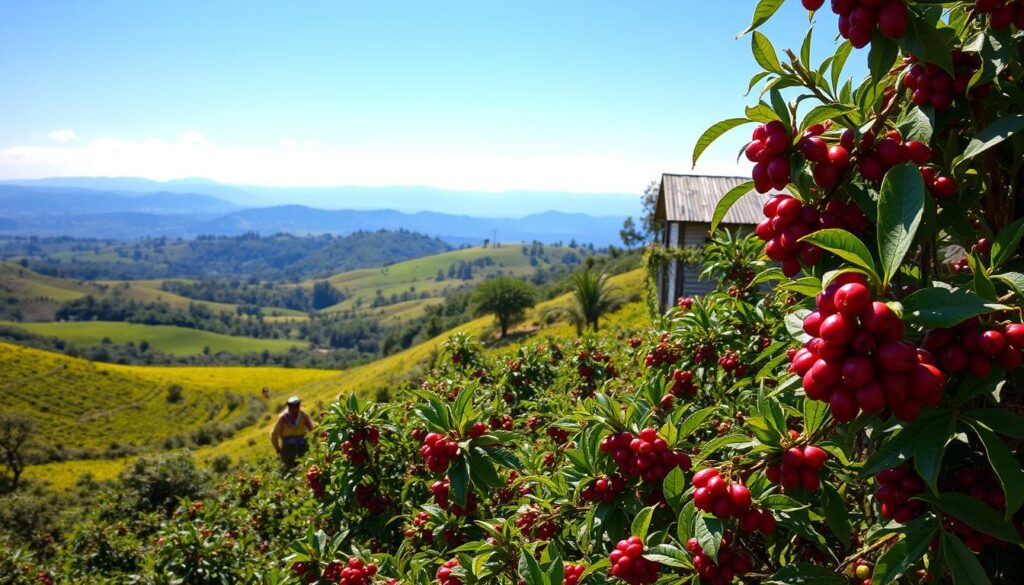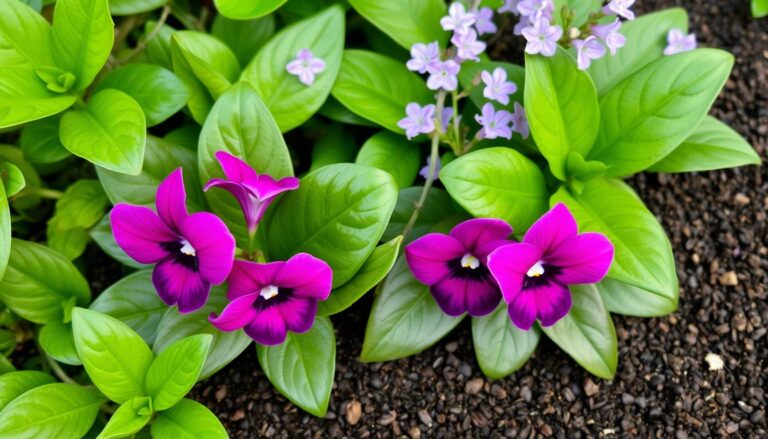Ever wondered what makes East African coffee so special? Kahawa, the Swahili word for coffee, has a long history. It started in the highlands of Ethiopia in the 15th century. Today, it’s a beloved drink across East Africa.
Visit Kahawa Café, opened in 2019 in Zug, Switzerland. Dive into the real flavors of this amazing region.
Key Takeaways
- Explore the rich history of Kahawa coffee, tracing its origins to the Ethiopian highlands.
- Discover the evolution of coffee from “qahwah” to the distinct “kahawa” in East Africa.
- Experience the distinctive flavor profiles and characteristics of East African coffee.
- Learn about the sustainable farming and direct trade practices behind Kahawa coffee.
- Uncover the modern Kahawa coffee experience, from artisanal roasting to optimal brewing.
The Rich Heritage of Kahawa Coffee
The story of coffee starts in East Africa, mainly in the Ethiopian highlands. It’s said that Kaldi, an Ethiopian herder, found coffee’s energizing effect on his goats. This ancient tale is part of coffee’s history. The Arabs called it “qahwah,” which became “kahawa” in Swahili. This change has shaped how we talk about coffee worldwide.
In Kenya, coffee is a big part of the culture and economy. Women do 90% of the work on coffee farms. Yet, they own only 1% of the land. The “table banking” system helps women in coffee to support each other and gain more power.
“Kahawa 1893 was founded in 2017 by Margaret Nyamumbo, a third-generation Kenyan coffee farmer, highlighting the company’s recent start.”
Kenyan coffee’s rich heritage shows the people’s resilience and creativity. From the Ethiopian highlands to East Africa’s culture, Kenyan coffee’s story is one of tradition and striving for the best.

Origins in Ethiopian Highlands
The legend of Kaldi, an Ethiopian herder, is fascinating. He discovered coffee’s energizing effect on his goats. The coffee plant, from the Ethiopian highlands, has been valued for centuries. It’s a source of food and cultural importance in the region.
Evolution from Qahwah to Kahawa
The coffee trade grew, and so did the names for it. The Arabs called it “qahwah,” which became “kahawa” in Swahili. This change has shaped coffee’s global language, leading to terms like “coffee” and “kaffee.”
Cultural Significance in East Africa
In Kenya, coffee is deeply rooted in culture and economy. Women do 90% of the coffee farm work. But, they own only 1% of the land. The “table banking” system helps women in coffee to support each other and gain more power.
East African Coffee Production
The East African region, including Kenya, Tanzania, Rwanda, and Congo, is known for its top-notch coffee beans. Kahawa 1893, started by Margaret Nyamumbo, buys its coffee from local farms and collectives. They pay farmers almost twice the minimum fair trade price, ensuring quality and sustainability.
In Burundi, small-scale farmers grow coffee using organic and sustainable methods. Their hard work and commitment to quality make East African coffee so popular.
“The specialty coffee market in Kenya stands out due to its quality and unique history.”
Kenya has a long history of coffee production, starting in 1893. Today, it’s the 16th largest coffee producer, employing millions. Kenyan coffee is famous for its arabica variety, grown at high elevations.
Kenyan coffee beans are graded by size, quality, and region. The AA grade and AB grade are the most valuable. The Nairobi Coffee Exchange helps growers and exporters connect, ensuring fair prices.
East African coffee is known for its bright acidity and unique flavors. You’ll find citrus, berry, and cocoa notes in every cup. It’s a treat for coffee lovers everywhere.
Distinctive Flavor Profiles and Characteristics
Explore the world of coffee from East Africa’s highlands. Burundi coffee is known for its bright acidity and complex flavors. It has notes of citrus, floral hints, and fruity sweetness.
The high altitude in Kenya and Tanzania makes East African coffees special. This quality comes from the unique growing conditions.
Unique Taste Notes and Aromatics
Burundi coffee’s taste changes with roast levels. You can choose from light, medium, or dark roasts. Each offers a different flavor experience.
Burundi’s Kahawa coffee shows the country’s coffee-making traditions. It carries the community’s cultural heritage in every cup.
Altitude and Growing Conditions
Kahawa coffee is grown by small farmers in Burundi. They use organic and sustainable methods. This care results in complex flavors, like berry and citrus notes.
Kahawa 1893 supports local farmers and communities. This makes their coffee even more valuable and authentic.
Processing Methods Impact on Flavor
Kahawa 1893 roasts their beans in small batches. This ensures freshness and quality. They offer a variety of coffees, like medium-dark roasts and decaf blends.
Try Kahawa coffee for a unique taste. It showcases East Africa’s rich coffee notes and flavor profile.

“Kahawa embodies Burundi’s rich cultural heritage, symbolizing community and tradition with every sip.”
Sustainable Farming and Direct Trade Practices
At Kahawa, we support sustainable coffee production and promote ethical production. We partner with coffee farmers in East Africa through direct trade. This ensures fair prices and supports sustainable farming. We invest in the communities that grow the beans we roast.
We have a bitcoin-powered tip fund for our customers to help female coffee farmers. This program has helped over 500 women, with 200 in Kenya. Our customers have given close to $45,000, which we’ve matched for a total of $90,000.
We focus on transparency, trust, and sustainability. Join us in making the coffee industry fairer and more sustainable. Enjoy the unique flavors of East Africa and help farmers thrive.

“Kahawa’s commitment to direct trade and sustainable practices sets them apart, ensuring that every sip supports fair compensation and community-driven development.”
The Modern Kahawa Coffee Experience
Dive into the world of Kahawa coffee and discover how it’s made. Kahawa focuses on quality, freshness, and sustainability. It honors the rich coffee heritage of East Africa.
Artisanal Roasting Techniques
Kahawa Café in Zug offers a unique artisanal roasting experience. Here, you can see how East African beans become the perfect coffee. They roast beans to bring out fruity, floral, smooth, and smoky flavors for everyone.
Brewing Methods for Optimal Taste
Bringing out the best in these beans needs skill in coffee brewing. Kahawa Café teaches you about espresso machines and brewing. They help you find the perfect coffee, whether it’s espresso or pour-over.
Storage and Freshness Tips
Keeping Kahawa’s beans fresh is key. The team at Kahawa Café shares tips on storage and freshness. They teach how to store beans and brew the perfect cup, so you can enjoy East Africa’s taste in every sip.
“At Kahawa, we’re not just serving coffee – we’re celebrating the rich heritage and vibrant future of East African coffee culture.”
– Margaret Nyamumbo, Founder of Kahawa 1893
Conclusion
The specialty coffee market is huge, making up 50% of global coffee trade. It has pushed U.S. coffee drinking to a 20-year peak. The market, worth about $28 billion, is set to hit $33 billion by 2029. East African coffees, like Kahawa from Kenya, Tanzania, and Burundi, are key to this growth.
These specialty African coffee types offer unique tastes, eco-friendly farming, and deep cultural roots. The story of Kahawa 1893, started by Margaret Yumo, shows the success of East African coffee. Kahawa 1893 focuses on fair trade, expert roasting, and working directly with farmers. This approach boosts coffee culture and brings real Kahawa tastes to coffee lovers.
The specialty coffee market is booming, and African coffee varieties like Kahawa are essential. By trying Kahawa’s complex flavors, you start a journey of cultural discovery. It’s a way to appreciate East Africa’s rich coffee heritage.






